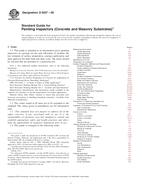Wir benötigen Ihre Einwilligung zur Verwendung der einzelnen Daten, damit Sie unter anderem Informationen zu Ihren Interessen einsehen können. Klicken Sie auf "OK", um Ihre Zustimmung zu erteilen.
ASTM E2841-11
Standard Guide for Conducting Inspections of Building Facades for Unsafe Conditions
Automatische name übersetzung:
Standard-Handbuch für die Durchführung von Inspektionen von Gebäudefassaden für Unsichere Bedingungen
NORM herausgegeben am 1.12.2011
Informationen über die Norm:
Bezeichnung normen: ASTM E2841-11
Anmerkung: UNGÜLTIG
Ausgabedatum normen: 1.12.2011
SKU: NS-46136
Zahl der Seiten: 8
Gewicht ca.: 24 g (0.05 Pfund)
Land: Amerikanische technische Norm
Kategorie: Technische Normen ASTM
Kategorie - ähnliche Normen:
Die Annotation des Normtextes ASTM E2841-11 :
Keywords:
ICS Number Code 91.060.10 (Walls. Partitions. Facades)
Ergänzende Informationen
| Significance and Use | ||||||
|
This guide is intended to provide building professionals with a methodology for conducting periodic condition assessments of building facades, for the purpose of determining if conditions exist in the subject facades that represent hazards to persons or property. It addresses the performance expectations and service history of a facade, the various components of a facade, and the interaction between these components and adjacent construction to provide a stable and reliable enclosure system. This guide was written as a parallel document to Practice E2270. Practice E2270 is written in the imperative form as a Standard Practice and is designed for adoption by specifying authorities. This guide is intended as a dissemination of explicit knowledge gained from experience of conducting periodic facade inspections. Implicit in this guide are general facade inspection techniques that have been tailored for periodic inspections. These tips and techniques are shared to provide a comprehensive template from which a facade inspection program can be tailored. QualificationsUse of this guide requires knowledge of basic physics, construction and building exterior wall design principles and practices. ApplicationThe sequential activities described herein are intended to produce a complete and comprehensive evaluation program, but all activities may not be applicable or necessary for a particular evaluation program. It is the responsibility of the professional using this guide to determine the activities and sequence necessary to perform an appropriate condition assessment for a specific building properly. Preliminary AssessmentA preliminary assessment may indicate that localized conditions in a wall system exist which are limited to a specific element or portion of a wall. The evaluation of causes may likewise be limited in scope, and the procedures recommended herein abridged according to the professional judgment of the investigator. A statement stipulating the limits of the investigation should be included in the report. ExpectationsExpectations about the overall effectiveness of a condition assessment program must be reasonable, and in proportion to a defined scope of work and the effort and resources applied to the task. The scope and effort of facade inspections is defined by the purchaser and provider of such services. The objective is to be as comprehensive as possible within a defined scope of work. The methodology in this guide is intended to address the intrinsic behavior of a facade system. Since every location throughout the building facade is not likely to be included in the evaluation program, it is possible that localized conditions of distress may not be identified. Conditions that are localized or unique may remain, and require additional evaluation. The potential results and benefits of the condition assessment program should not be over-represented. This guide is not intended for use as listed below. In each instance, more appropriate standards or guides exist. As a design guide, design check, or a guide specification. Reference to design features of a wall is only for the purpose of identifying items of interest for consideration in the condition assessment process. As a construction quality control procedure, or as a preconstruction qualification procedure. As a diagnostic protocol for evaluating buildings for water leakage or other performance related problems. As a sole evaluation of fa�ade damage arising from natural or manmade event/disasters. |
||||||
| 1. Scope | ||||||
|
1.1 This guide is intended to establish procedures and methodologies for conducting inspections of building facades including those that meet inspection criteria for compliance with Practice E2270. For the purposes outlined in this guide, unsafe conditions are hazards which could result from loss of facade materials. 1.2 Investigative techniques discussed may be intrusive, disruptive or destructive. It is the responsibility of the investigator to establish the limitations of use, to anticipate and advise of the destructive nature of some procedures, and to plan for patching and selective reconstruction as necessary. 1.3 The values stated in inch-pound units are to be regarded as standard. No other units of measurement are included in this standard. 1.4 This standard may involve hazardous materials, operations, and equipment. This standard does not purport to address all of the safety problems associated with its use. Establish appropriate safety and health practices and determine the applicability of regulatory limitations prior to use. Awareness of safety and familiarity with safe procedures are particularly important for aboveground operations on the exterior of a building and destructive investigative procedures that typically are associated with the work described in this standard. |
||||||
| 2. Referenced Documents | ||||||
|
Ähnliche Normen:
Historisch
1.2.2009
Historisch
1.2.2008
Historisch
1.1.2007
Historisch
15.2.2009
Historisch
1.4.2012
Historisch
1.10.2013
Empfehlungen:
Aktualisierung der technischen Normen
Wollen Sie sich sicher sein, dass Sie nur die gültigen technischen Normen verwenden?
Wir bieten Ihnen eine Lösung, die Ihnen eine Monatsübersicht über die Aktualität der von Ihnen angewandten Normen sicher stellt.
Brauchen Sie mehr Informationen? Sehen Sie sich diese Seite an.



 ASTM D6237-09
ASTM D6237-09 ASTM D6513-08
ASTM D6513-08 ASTM D7254-07
ASTM D7254-07 ASTM D7445-09
ASTM D7445-09 ASTM E1825-06(2012)..
ASTM E1825-06(2012).. ASTM E1886-13a
ASTM E1886-13a
 Cookies
Cookies
